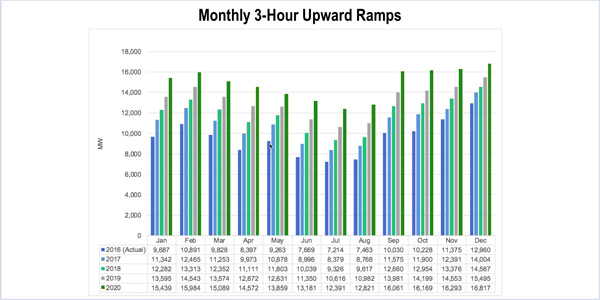By Jason Fordney
Power sellers and utilities in CAISO are urging the grid operator to develop a long-term plan to procure the flexible capacity resources increasingly needed to manage the integration of variable renewable generation.
Market participants commented on a recent stakeholder meeting regarding the ISO’s Flexible Resource Adequacy Criteria and Must Offer Obligation Phase 2 (FRACMOO 2) proposal. The ISO is proposing to introduce new variations in its flexible resource adequacy (RA) capacity product, which is intended to increase the ramp rate of the flexible capacity fleet. (See CAISO Flex Capacity Effort Targets Increased Variability.) CAISO is needing quicker ramping speeds within shorter time cycles as more renewables are brought into the system.
The current proposal is a set of short-term solutions, and CAISO said it will later develop a “long-term RA roadmap” to integrate system, local and flexible capacity needs, and state renewable portfolio standards.
The bulk of the current proposal represents short-term modifications to the flexible capacity criteria to emphasize start-up and minimum run times. CAISO is exploring the use of intertie resources but does not yet have a specific proposal. It hopes to have a program in place in time for the 2020 RA year.
Southern California Edison (SCE) said it is not a function of the resource adequacy program to optimize resources, as stated in a Brattle Group proposal discussed in the stakeholder call. Brattle included “products to optimally utilize resources” as a goal of flexible capacity, but SCE said that optimal use is the role of the wholesale market. The RA program is meant to ensure that capacity is available via a must-offer obligation. “SCE does not believe that the CAISO has clearly demonstrated where the current three-hour product is failing,” the company said.
Powerex, which markets BC Hydro output, commented that CAISO should examine why flexible capacity needs are causing challenges and how to make “cost-effective resource investments” to achieve environmental goals. Powerex said the ISO should develop additional tools to reduce the magnitude and steepness of net load ramps when they would otherwise exceed available flexible capacity in real time, allowing it to procure additional flexible capacity from existing resources.
The Western Power Trading Forum (WPTF) said that “this initiative does not have to be the end all, be all in incenting flexibility from the CAISO fleet. The CAISO can also enact energy market reforms and, if necessary, procure backstop capacity.” The group urged the ISO to keep the proposal simple and target products that will incentivize load-serving entities to contract with the most flexible resources, and incent interties to economically offer in their capacity.
“This will provide proper market incentives resulting in economically efficient outcomes, including the potential of the retirement of less flexible, unneeded capacity,” WPTF said.
The Alliance for Retail Energy Markets, a group representing competitive suppliers — including Constellation NewEnergy, Direct Energy and Noble Americas Energy Solutions — contended that CAISO should identify the root causes of the reliability needs and develop a market-based solution that properly assigns costs and provides price signals.
“In spite of many years of effort, the CAISO is still seeking to understand the flexible needs on the system,” the group said in its comments. “In addition, the continued focus of the CAISO on specifying prescriptive capacity procurement requirements for load-serving entities (LSEs) is fundamentally misplaced and excessively burdensome.” Meeting flexible capacity needs through ancillary services would provide transparency and investment signals for new resources, the suppliers said.
CAISO plans to have a draft final FRACMOO 2 proposal early next month and approval from the Board of Governors by the second quarter of 2018.




